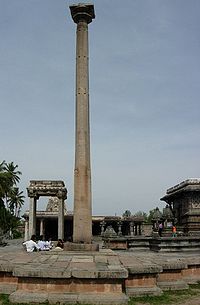Hoysala
The Hoysala were an Indian dynasty that ruled a stable state in what is now the state of Karnataka between approx. 1040 and 1345 . She was a vassal of the Chalukya until around 1190 and was replaced by the Vijayanagar Empire in 1346 .
Origin and advancement
The term originally referred to a tribe that produced "highwaymen and troublemakers" in the forests and mountains of Karnataka during the Kalabhra period (from 250). When they came to power, their princes became defenders of the Hindu order.
In the early 12th century, the Hoysala were among the great vassals of the Chalukya . As early as 1117, King Vishnuvardhana (ruled approx. 1108–1142) founded the Chennakeshava Temple in Belur , their capital at the time, after a success against the Chola . Around 1122 he even acted against the well-known Chalukya king Vikramaditya II (r. 1076–1127) and lost. Vishnuvardhana is also known as the patron of the philosopher Ramanuja (* 1017–1137).
The independent kingdom
But after the death of Vikramaditya II, the Chalukya empire fell apart . The Hoysala under Vishnuvardhana's grandson Vira Ballala II (r. Approx. 1173-1220) were able to take over the succession around 1190 with victories over the Chalukya of King Someshwara IV and the Yadava king Sevuna Bhillama V. A marriage alliance with the Chola served as further security . Ballala II continued to build his grandfather's temple in Belur.
The neighbors of the Hoysala were the Yadava kings of Devagiri (also former vassals of the Chalukya in the north, between Narmada and Godavari) and the Pandya kings of Madurai in the south. The latter succeeded the Chola in the early 13th century and finally presented a serious threat to the Hoysala under Jatavarman Sundara (ruled 1251–1268). The Hoysala king Someshvara II (ruled 1234–63) fell in one The battle against Jatavarman Sundara and the question of succession caused the division of the empire for about thirty years.
The ancestral land of the Hoysala dynasty was in the southwestern mountainous region, the capital was Dvarasamudra (now Halebid ), almost 170 km northwest of Mysore . The cultural legacies of the dynasty consist of great temples - e. B. in Belur (Chennakeshava Temple, around 1117), Halebid (Hoysaleshwara Temple, from 1121), Somanathapura (Chennakeshava Temple, around 1268) and in Shravanabelagola . The art of poetry in the Kannada language was also in bloom.
Defeats to the Muslims and succession by Vijayanagar
Malik Kafur, the general of the Delhi Sultan Ala ud-Din Khalji , with the support of the Yadava King, set out against the Hoysala Empire in 1311 and took its capital by forced marches, as King Vira Ballala III. (r. 1291–1343) was on a campaign against the Pandya kings of Madurai . Ballala III. all that remained was surrender and tribute.
As a result, the Hoysala lost the entire northern border to the Delhi Sultan Muhammed Tughluk (r. 1325–1351), who in 1327 also had the capital Dvarasamudra destroyed. In response to the sultan's expansion, Ballala III continued. with some probability the brothers Harihara and Bukka as margraves in Vijayanagar (mentioned in inscriptions as early as 1320, as well as a city founded by Ballala III.). They founded the empire of the same name of Vijayanagar .
Ballala III. lost the battle of Trichinopoly in 1342 against Ghiyas-ud-din, the sultan of Madurai (the sultanate was founded in 1334), was captured and executed. Harihara of Vijayanagar apparently took over many of his territories and after the death of Ballala IV. 1345 also the succession of the Hoysala dynasty, with the widow Ballalas III. was named before him for honor in 1349.
Kings
- Vinayaditya (ruled approx. 1047–1101)
- Vishnuvardhana (ruled approx. 1108–1152)
- Narasimha I. (ruled approx. 1152–1173)
- Vira Ballala II (r. 1173-1220)
- Narasimha II (r. 1220–34)
- Someshvara II. (R. 1234-63)
- Narasimha III. (-1291) and Ramanatha (-1293)
- Vira Ballala III. (ruled 1291–1343)
- Vira Ballala IV. (R. 1343-1345)


